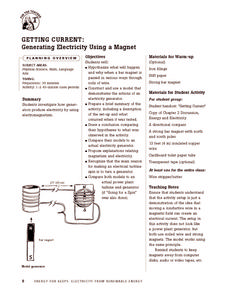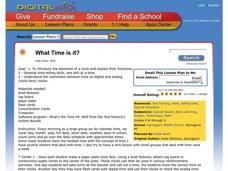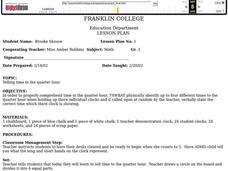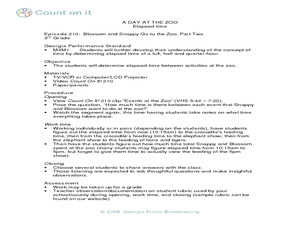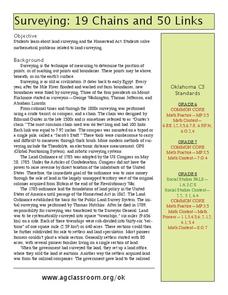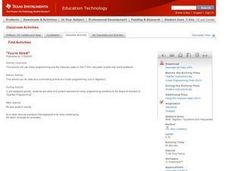Curated OER
Mystery Spinners
Take a spin with probability. Given a set of clues about the probability of events on a spinner, groups create their own device to match the clues. Using a jigsaw strategy, groups share their spinners and strategies with other...
Energy for Keeps
Getting Current: Generating Electricity Using a Magnet
Give your class a magnetic charge with this creative experiment designed to teach emerging scientists about electromagnetism. Pupils construct a model that demonstrates the function of an electrical generator and test this creation in a...
Curated OER
Classifying Triangles Based On Properties of Angles
The interactive lesson plan featured here calls for the use of a Smartboard for sorting and classifying shapes. Then, pupils discuss the rules they followed for sorting their shapes, particularly focusing on the properties of angles....
Curated OER
Sum of Angles on a Triangle
Use this lesson for a basic review of angles. While the activities discussed are outlined, there are no materials provided to make implementation possible. When using this resource, it is necessary to create worksheets and other...
Curated OER
Telling time to the quarter hour
Second graders identify how to tell time to the quarter hour. Then they complete a worksheet of twelve problems on their own given ten minutes and getting at least eight correct. Students also practice telling time as a class while the...
Curated OER
What Time Is It?
Fourth graders distinguish between analog and digital clocks and read time from both types. In this clock reading lesson, 4th graders discuss the types of clocks and the time zones. Students find times in specific time zones. Students...
Curated OER
What Time is it?
Students participate in three centers focused on developing time-telling skills. In this time lesson, students create their own paper plate clock face, play "Time Concentration" using times on the hour and half hour, as well as, practice...
Curated OER
Telling Time
Third graders use a clock to physically identify time at the quarter hour. As a class, they are randomly called on and expected to hold up their clock with the correct time. They complete a worksheet and answer questions to complete...
Curated OER
What time is it, Mr. Clock?
Students practice telling time through movement, teamwork and cooperation - as they demonstrate how a clock represents time. They play a game of telling time in order to master the lesson objectives.
Curated OER
Time & Itineraries Two
Students explore time management by participating in clock reading activities. In this itinerary lesson, students define a list of time telling vocabulary terms and practice reading analog clocks with a partner. Students identify ways to...
Curated OER
Clocks and Time
Second graders observe and demonstrate how to tell and write time. They discuss different ways and things that tell time, then listen to a teacher-led lecture about the hands on a clock. Students complete a worksheet along with the...
Curated OER
A Day at the Zoo - Elapsed Time
Third graders discover the concept of elapsed time. In this time instructional activity, 3rd graders watch a video which shows zoo feedings. They work in groups to find the elapsed time between feedings.
Lesson This!
Math Lesson Plan: Bingo Dabbing by 5's
Those extra large markers or "bingo dabbers" are so much fun to play with! Let learners use them to dab groups of five and practice skip counting by 5s to 100 or to 200.
Curated OER
Sea and Learn - Lesson Plan: Dockyard Maties
Pupils solve word problems involving money using all four operations listed, and convert pre-decimal currency into decimal currency. They discuss how dockyard mates were paid and the equivalence with today's money, and complete a...
Curated OER
Ponzi? An April Fool's Day History and Economics Lesson Plan
Students explore the concept of a Ponzi Scheme. In this economics lesson, students invest in a product called Thin-Cups. Students invest money in this product over the course of a couple weeks. Students discover how a Ponzi Scheme works...
Curated OER
19 Chains and 50 Links
Students investigate surveys as it relates to chains and links. In this math lesson, students relate math to history and surveys done above, below and on the earths' surface. They review vocabulary pertaining to this lesson before moving...
Curated OER
New Ways to Measure
Students recognize that measuring tools can come in many different shapes and sizes. In this early childhood math activity, students develop creative-thinking, math, and social skills as they use nontraditional measuring tools.
Curated OER
Graze Like a Cow
Students explore how a cow digests the grass they eat. In this science/math instructional activity, students compare the quality of forage. Additionally, students determine the effects of rangeland health on the production.
Curated OER
Profit From Pumpkins
Third graders cut open a pumpkin. In this math lesson, 3rd graders complete the worksheet "From Seed to Pumpkin" and then clean out their pumpkins to see how many seeds are in it.
Curated OER
Tick Around the Clock
Students examine and discuss the differences between clocks they are shown. Using the internet, they research how people used to tell time before clocks. They review what the long and short hand on the clock represent and practice...
Curated OER
"You're Hired!'
Students investigate linear programming using the TI. In this algebra lesson, students collaborate and graph linear inequalities on a TI. They analyze their data and present it to the class.
Curated OER
Money Vocabulary
Explore the monetary system by completing worksheets in class. Learners will identify the monetary units of England and collaborate in groups to solve money word problems. They also identify several money-related vocabulary terms before...
Curated OER
Candy Bar Measurements
Geometers explore mathematics by completing an object measurement worksheet. They utilize a variety of candy bars and rulers to conduct a measurement experiment in class. They complete worksheets as a group based on the measurement...
Curated OER
Coordinates on a Shower Curtain: Math
Students use a shower curtain to represent a coordinate plane and then physically demonstrate their understanding or ordered pairs as they move from place to place.



